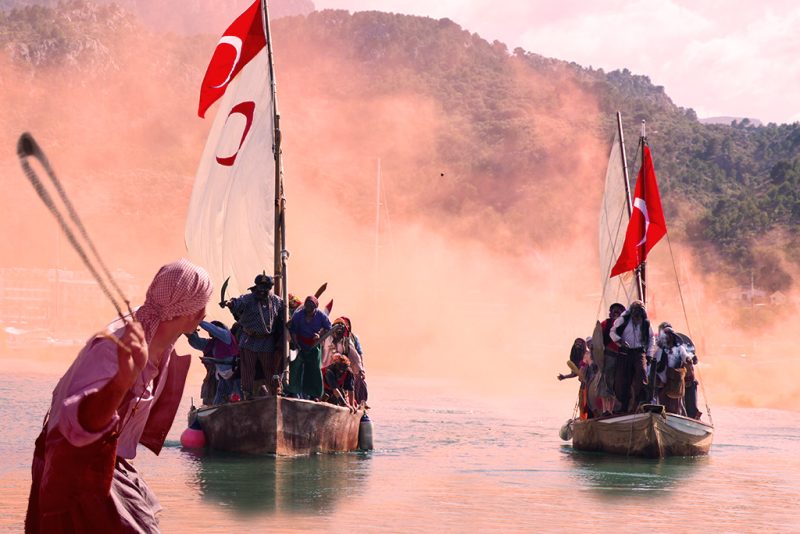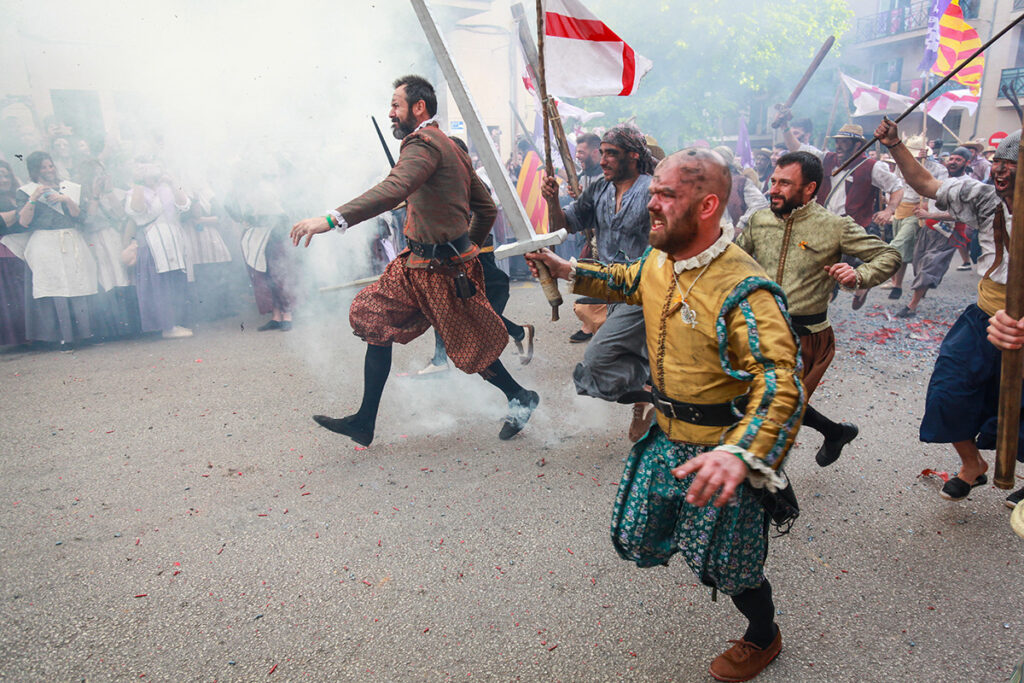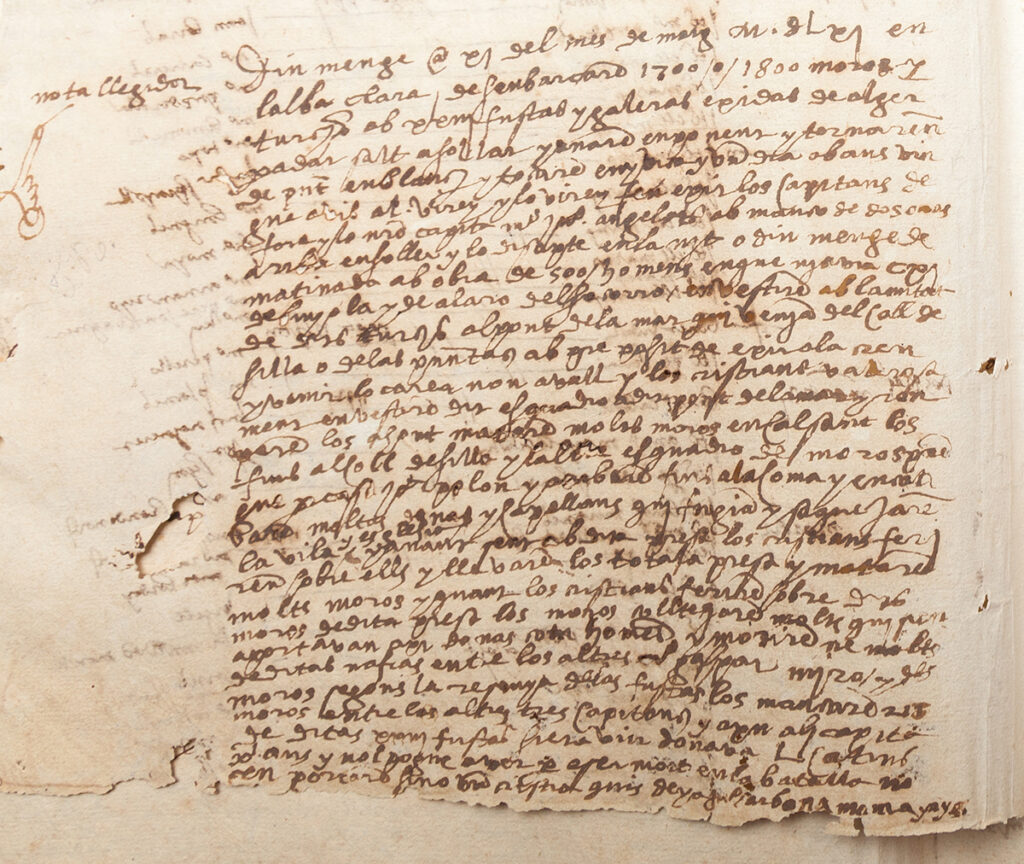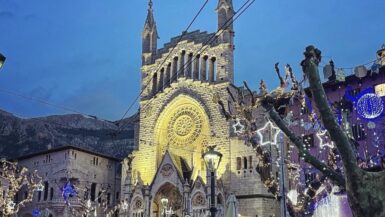The Feria and Firó are the most popular festivities held in the municipality, celebrating the victory of the “sollerics” against the Saracen invasion that took place on May 11, 1561.
These festivities last four days, despite their preparation requiring months of work. During these four days, numerous cultural and sporting events are held, among which stand out the reading of the “Pregón” (opening speech) by a prominent local figure, the investiture of the “Valentes Dones” (Brave Women) who embody historical figures that bravely defended their honor against the Saracen attack, and the flower offering to the Virgin of Victory.
The festival has two very distinct parts. The “Fira” itself, held on the second Sunday of May, features a market by local artisans showcasing native and typical valley products, along with an agricultural and animal fair displaying indigenous animals.
On the other hand, there is the “Firó,” which takes place the Monday following the “Fira.” It is the main celebration, meticulously organized months in advance by all participating groups. It includes a historical reenactment of the Saracen invasion of the city, from their landing at the port to the fierce defense by the sollerics, who, after three battles, managed to defeat them in Sóller’s main square. The “Firó” is characterized by its noisy nature with thunderous sounds, firecrackers, and fireworks, where the joy and passion of the sollerics for their town and history become more than evident.

History
A deeply rooted festival in which the people of Sóller commemorate, every second Monday of May, the defense of the valley and subsequent victory of the “sollerics” over the invading Moors on May 11, 1561. In 2004, the 150th anniversary of the festival was celebrated. It is a commemoration that the rest of the island has never turned its back on, and a large number of visitors come to attend the Firó.
There are three contemporary accounts of the Moorish landing in Sóller in 1561, written within the week following the event. The first, by the municipal scribe, is kept in the Archive of the Town Houses; the second, practically unpublished, was written by the notary Antoni Morell and is preserved in the Archive of the Kingdom of Mallorca; and the third, from the same Archive, written by the jurors of the Kingdom in the form of a letter addressed to King Philip II. Later, in the 18th century (1557?), the Common of Preveres of the parish of Sant Bartomeu reinterpreted it, collecting many of the traditions and legends accumulated over the past two hundred years and introducing numerous religious connotations. Finally, in 1833, the Franciscan friars of the Convent of Jesus made a new description of the Common of Preveres, embellishing it with a considerable proportion of biblical quotes.
The legends and traditions introduced in the two writings after the events include anecdotes such as the “Valentes Dones” (Brave Women), the Sacred Forms, the Three Crosses, Na Margarida Custurer, Saint James, and others surrounding this day. Of all these traditions, the one currently represented at the Firó Festival is that of the Brave Women for having killed two Moors with the bar used to close the door.
The victory of the “sollerics” against the Turks in 1561. Piracy and privateering were quite common naval military practices in the 16th century, encouraged and partially funded by public institutions. Privateers were merely individual shipowners who armed a vessel and went out in search of booty. With prior authorization from the King or his representative, privateers attacked the coasts of enemy kingdoms and captured any ship, person, clothing, money, or merchandise they encountered.
The first warning bell.
At the beginning of May 1561, the Viceroy of Mallorca, Guillem de Rocafull, sent two armed frigates on a privateering mission to North Africa. The mission of the ships was to harass the coasts of Algiers, which had become a nest of Turkish pirates that terrified the entire Mediterranean. Thanks to this measure, the ships were able to capture eight Turks who, skillfully subjected to torture, confessed. Thus, the Viceroy learned that a powerful enemy fleet was prowling the coasts of the western Mediterranean and intended to attack one of the Mallorcan towns.
On Saturday, May 10, news arrived that a fleet of 23 Turkish ships was cruising the waters around Ibiza and had stopped on the island to stock up on water. Since the Viceroy could not determine which Mallorcan town they had decided to plunder, and to prevent greater harm, he ordered the captain of each town to move to their respective destinations to organize the defense.

The Landing
On Sunday, May 11, 1561, the day of Saint Pontius, between 1700 and 1800 Turkish and Algerian corsairs landed at Ses Puntes, probably guided by a former slave who had escaped from Sóller and knew the area well. The Turks began to disembark just before four in the morning, at dawn. As soon as the guards on duty at the hut on Coll de s’Illa noticed the presence of the Turks, they abandoned their post and ran down to the town, blowing the horn to warn the “sollerics.”
The Moors, all together, ascended on foot to Coll de s’Illa and continued towards the estate of Sa Figuera, Son Llempaies, and Coll den Borrassà until reaching son n’Avinyona. From there, they split into two groups. The larger group, consisting of about 800 to 1,000 men, headed towards l’Horta with the intention of crossing the Pont den Barona and climbing the Camp Llarg path to the convent crossroads, in order to enter Sóller through Carrer Nou. The rest entered the town through Ses Argiles, towards the Pont dels Ases, and then through Victòria Street and Lluna Street. The maneuver was quite cunning: the plan was to catch the “sollerics” between two fires while everyone was still asleep. The Turks relied on the element of surprise to diminish the “sollerics” capacity to react and to secure victory.
The defense
However, they became overconfident. The Turks did not count on the fact that the Viceroy was aware of their itinerant presence and had activated the usual defense protocol: he sent the captain of arms to Sóller to gather all men available to fight, and requested a relief squadron from the towns of Bunyola and Alaró. No one knows why Santa Maria was not notified. In total, between 450 and 500 men from Sóller and Fornalutx gathered, organized into three groups under the command of Captain Joan Angelats, plus two additional groups (111 men in total) from Bunyola and Alaró, under the command of Captains Ignasi Garcia and Pere de Sant Joan, respectively. All of them were armed with spears and pikes, arquebuses, and crossbows. Additionally, Angelats reinforced the garrison at the Port fortress, in case the corsairs decided to attack there.
Around five in the morning, the news of the Turks’ landing reached Sóller. Captain Angelats had just gathered the men and positioned them at Camp de s’Oca, which was the logical access route from the sea. At the same time, he ordered the bells to be rung and for the women, the elderly, and the children to leave the town and take refuge in the mountains; he sent Reverend Antoni Canals, with a horse, to oversee the evacuation.
The Battle of Pont den Barona
Shortly after, the larger group of Moors reached Pont den Barona and, from the bridge, discovered the Christian camp. There were moments of confusion. They had not anticipated that anyone would be waiting for them and, instead of surprising the enemy, they were the ones surprised. The pirates did not know the exact number of Christian combatants or their defensive capabilities, and began firing arquebus shots from the bridge to see how they would react. At the same moment, the knight returned from Sóller and informed the troops that the rest of the corsairs had entered the town from the other side and were looting it.
These were moments of maximum bewilderment. The captains and the most experienced fighters gathered to decide what course of action to take. Fearing to remain caught between two fires, Sergeant Antoni Soler recommended attacking the group in front of them and leaving the defense of the town for later. Soler was a veteran fighter in the armies of Emperor Philip II, highly respected among his fellow citizens, who listened to and accepted his opinion.
With the determined charge of the “sollerics,” the Turks were intimidated and began to flee. The Christians gained confidence and pursued them along the road to the Port, l’Horta, and Puig den Muntaner until reaching son n’Avinyona, where they killed the captain (rais) commanding the invading troops. It is said he was Issuf, the son of Ulutx Ali, the fleet commander. “Sollerics” Miquel Canals and Nicolau Bisbal also perished in this battle. The rais’s personal guard fled towards the ships but, in their flight, encountered a group of bandits and their hunting dogs, who confronted them and scattered them.
Meanwhile, about 200 defenders continued chasing the fleeing Moors through the olive groves of Sa Figuera, the Port plain, and the Cingle until s’Illeta, killing and wounding many.

The Battle of son n'Avinyona
Once the bulk of the attackers had been annihilated, Captain Angelats and his men decided to regroup and wait for the rest near Son n’Avinyona. He was convinced that, soon enough, those who had looted the town and its surroundings would return to the ships following the same route as before. He was not mistaken. Shortly thereafter, the corsairs appeared, laden with clothes, money, jewels, and people they had taken prisoner after looting the church and reaching Sa Coma. A new battle ensued in the field of Son n’Avinyona, in which the Turks were once again intimidated and ended up fleeing, abandoning everything they were carrying, including their weapons.
A squadron of Moors, pursued by a group of 25 “sollerics,” got disoriented upon reaching the bridge of Ses Alzines and took the path towards Ginjolar (Can Baixo). Upon reaching the plain of Ginjolar (near the landfill), the “sollerics” caught up with them, and a fierce confrontation ensued. The Turks, having nothing to gain and much to lose, abandoned their loot and the prisoners they were carrying, stabbing some of them. They killed Reverend Gaspar Miró and a daughter of Pere Canals, and left Reverend Antoni Roger badly wounded.
As before, the “sollerics” chased the Moors until they re-embarked and set sail shortly after noon.
The final balance
In total, it seems that 211 Turks died, including three captains (rais), and about half a dozen “sollerics” combatants, not counting a large number of wounded on both sides, some of whom later died from their injuries. Only one prisoner was captured, who was wandering around s’Illeta; while the Moors took a Fornalutx man, Joan Arbona, who was on guard at the Coll de s’Illa watchtower and, it appears, was lame.
Much of the loot the corsairs had taken was recovered. At the end of the day, the items were gathered in the town square and returned to their rightful owners, after they swore an oath.
On Tuesday, May 13, 1561, the Jurats (Councilors) of the Kingdom of Mallorca sent a letter to King Philip I recounting the events in Sóller, magnifying the actions and morale of the defenders, and highly praising Viceroy Rocafull and the preventive measures they had taken for the defense of the island.
Plàcid Pérez i Pastor (historian)





Leave a reply